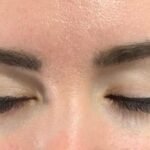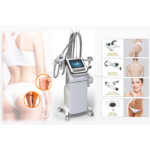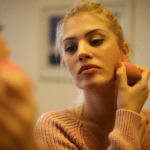This Site Is A Participant In The Amazon Services LLC Associates Program. We may earn money or products from Amazon or the companies mentioned in this post.
An esthetician performs extractions by using special tools to remove impurities from the skin, such as blackheads and whiteheads. In this process, the esthetician applies gentle pressure to the affected area to extract the buildup.
Extractions are a vital part of a facial treatment as they help to unclog pores and improve the overall appearance and texture of the skin. Additionally, extractions can help prevent future breakouts and promote a clearer complexion. It is important to have extractions done by a trained and experienced esthetician to ensure that the process is done safely and effectively, minimizing the risk of any skin damage or scarring.
So, let’s delve deeper into the process of how an esthetician performs extractions and the importance of this step in a skincare routine.
:max_bytes(150000):strip_icc()/extractions-57926a473df78c1734994311.jpg)
Credit: www.verywellhealth.com
The Role Of An Esthetician In Skin Extractions
Esthetician’S Expertise In Assessing Skin Conditions
- Estheticians are skincare professionals who specialize in the assessment and treatment of various skin conditions.
- They undergo extensive training to develop a keen eye for identifying different skin types and their specific needs.
Understanding The Client’S Skin Type And Needs
- Before performing extractions, estheticians carefully analyze the client’s skin type, including its texture, oiliness, and overall condition.
- They take into consideration any existing skin issues, such as acne, blackheads, or whiteheads, in order to tailor the extraction process accordingly.
Identifying Specific Areas For Extractions
- Estheticians utilize their expertise to pinpoint the areas of the client’s skin that require extractions, focusing on areas with blockages such as clogged pores or congested follicles.
- By identifying these specific areas, estheticians ensure that the extraction process effectively targets the underlying blemishes.
Execution Of Extractions With Utmost Care
- Estheticians undergo specialized training to perform extractions safely and hygienically.
- They use sterilized tools, such as comedone extractors or lancets, to gently remove impurities from the skin.
- Extractions are carried out in a controlled manner, avoiding excessive pressure or harsh movements that could damage the skin.
Post-Extraction Skincare Recommendations
- After performing extractions, estheticians provide clients with post-treatment skincare recommendations.
- These recommendations may include using antibacterial or soothing products to reduce inflammation and prevent infection.
- Estheticians also educate clients about proper at-home skincare routines to maintain the results of the extractions.
Importance Of Regular Professional Esthetician Extractions
- Regular extractions performed by a skilled esthetician can help improve the overall condition and appearance of the skin.
- By removing impurities and blockages, extractions contribute to a clearer complexion and minimize the risk of acne breakouts.
- Additionally, estheticians can offer personalized advice on maintaining healthy skin between professional treatments.
Collaborative Approach With Clients
- Estheticians value open communication with their clients throughout the extraction process.
- They listen to the client’s concerns, answer their questions, and ensure that they feel comfortable and informed about the procedure.
- Feedback from clients is highly regarded by estheticians, allowing them to continuously improve their techniques and provide the best possible results.
Preparing For Extractions
Cleansing And Preparing The Skin
Before performing extractions, estheticians follow specific steps to prepare the skin for the procedure. This ensures that the skin is clean and ready to undergo the extraction process. Here are the key points to consider:
- Cleansing the skin: The esthetician starts by thoroughly cleansing the client’s face using a gentle cleanser. This helps remove any dirt, oil, or impurities present on the skin’s surface. It is essential to use a cleanser suitable for the client’s skin type to prevent any irritation or complications.
- Evaluating the skin condition: After cleansing, the esthetician carefully examines the client’s skin to assess its condition. They look for clogged pores, blackheads, whiteheads, and other potential extraction targets. By evaluating the skin, estheticians can determine the most effective course of action for each client.
- Application of toner: To further prepare the skin, estheticians apply a toner. Toner helps balance the skin’s ph levels and removes any remaining traces of cleanser. It also helps tighten the pores, making the extraction process more manageable.
Importance Of Steaming And Exfoliating
Steaming and exfoliating are crucial steps in the preparation process for an extraction. They offer several benefits that enhance the effectiveness and ease of extractions. Here’s why these steps are essential:
- Steaming the skin: Steaming is a valuable technique as it helps to open up the pores. The esthetician exposes the client’s face to warm steam, usually via a steamer, which softens the skin and loosens debris trapped in the pores. This makes the extraction process more comfortable and reduces the potential for any discomfort or skin damage.
- Exfoliating the skin: Exfoliation is another important step prior to extractions. Estheticians use gentle exfoliants to remove dead skin cells and unclog pores. This helps to minimize the buildup of sebum, dirt, and bacteria on the skin’s surface, reducing the likelihood of future breakouts. Exfoliating also enhances the overall appearance and texture of the skin.
- Stimulating blood circulation: Both steaming and exfoliating stimulate blood circulation in the skin. This increased blood flow brings fresh oxygen and nutrients to the surface, promoting a healthier complexion. It also aids in the removal of toxins from the skin, resulting in a clearer and more revitalized appearance.
Selecting Appropriate Tools And Products
Using the right tools and products is crucial to ensuring a successful extraction process. Estheticians must carefully select the tools and products that will be most effective for each client. Consider the following key points:
- Proper extraction tools: Estheticians use specialized tools like comedone extractors to safely remove blackheads, whiteheads, and other pore blockages. These tools are designed to apply gentle pressure around the targeted area without causing any harm to the skin.
- Professional-grade products: It is essential to use high-quality skincare products during the extraction process. Estheticians choose products that are suitable for the client’s skin type and concerns. Professional-grade exfoliants, cleansers, toners, and masks ensure optimal results and minimize the risk of skin irritation or adverse reactions.
- Hygiene and safety measures: Estheticians prioritize hygiene and safety when performing extractions. They sterilize their tools before and after each procedure to prevent the spread of bacteria or infection. Additionally, disposable gloves are worn to maintain cleanliness and prevent any cross-contamination.
Preparing for extractions is a vital step in an esthetician’s process. By cleansing and preparing the skin, utilizing steam and exfoliation, and selecting appropriate tools and products, estheticians create an optimal environment for successful extractions.
Performing Extractions
Understanding Different Extraction Techniques
Extractions are a vital part of an esthetician’s toolkit for achieving clearer, healthier-looking skin. There are various techniques used by estheticians to effectively remove impurities and blemishes from the skin. Here are some key points to understand about different extraction techniques:
- Manual extractions involve the use of a sterilized tool, such as a comedone extractor or lancet, to gently remove blackheads, whiteheads, and other types of clogged pores. The esthetician applies a controlled amount of pressure in a specific direction to eliminate the buildup within the pore.
- Mechanical extractions involve the use of a vacuum-like device that suctions out impurities from the skin. This technique is often used for more stubborn or deep-seated blackheads and congestion.
- Chemical extractions involve the application of specialized products, such as enzymes or chemical peels, to dissolve and remove blemishes. These products work by breaking down the debris within the pore, making it easier for the esthetician to extract.
- Ultrasonic extractions utilize high-frequency soundwaves to loosen and remove impurities from the skin. This technique is effective for clearing out congested pores and promoting a more radiant complexion.
Application Of Gentle Pressure And Correct Angles
One of the key aspects of performing extractions is the application of gentle pressure and the use of correct angles. This ensures that the process is effective while minimizing the risk of damaging the skin. Here are some important points to consider:
- The esthetician should always use gentle and controlled pressure when performing extractions to prevent tissue trauma or scarring. Applying too much force can lead to inflammation and skin damage.
- Different types of blemishes require specific angles of pressure to be successfully extracted. For example, blackheads are typically extracted by applying downward pressure, while whiteheads may be gently squeezed from the side.
- The esthetician must have a thorough understanding of skin anatomy to properly assess the angle at which pressure should be applied. This helps to prevent unnecessary pain for the client and reduces the risk of causing additional skin issues.
Addressing Various Types Of Skin Blemishes
There are different types of skin blemishes that an esthetician may encounter during the extraction process. It is important for the esthetician to address each type appropriately to achieve optimal results. Here are some key points to consider:
- Blackheads: These are caused by the buildup of excess oil, dead skin cells, and bacteria within the pore. Estheticians can manually extract blackheads by applying gentle pressure with a comedone extractor or using a suction device.
- Whiteheads: These are similar to blackheads but are covered by a thin layer of skin. The esthetician may use a sterilized tool to gently puncture the surface of the whitehead before applying pressure to remove the trapped debris.
- Papules and pustules: These are inflamed blemishes that may require a different approach. Estheticians can apply a warm compress to the area to soften the blemish before gently extracting the contents using a sterilized tool.
- Cysts and nodules: These deeper, more severe blemishes require professional attention and should not be extracted at home. Estheticians may recommend alternative treatments or, in some cases, refer the client to a dermatologist for further evaluation.
By understanding different extraction techniques, applying gentle pressure, and addressing various types of skin blemishes, estheticians can effectively perform extractions to help clients achieve clearer and healthier-looking skin.
Safety And Hygiene Considerations
Extractions are a crucial part of an esthetician’s job, as they help remove impurities and improve the overall complexion of the skin. However, it is essential to prioritize safety and hygiene during the extraction process to prevent any adverse reactions or infections.
Here are some key considerations to keep in mind:
Importance Of Maintaining A Sterile Environment
- Prioritize cleanliness: A clean workspace is vital to prevent the spread of bacteria and minimize the risk of infections. Thoroughly clean and disinfect the treatment area before and after each session.
- Wash hands: Always start by washing your hands with antibacterial soap. This simple step helps eliminate any germs that may be present on your hands.
- Disinfect tools and equipment: Sterilize all extraction tools and equipment using medical-grade disinfectants. This practice ensures that you are working with clean instruments and reduces the chances of contamination.
- Use disposable materials: Whenever possible, opt for disposable materials such as cotton pads, tissues, and gauze. These items minimize the risk of cross-contamination and facilitate a hygienic environment.
Using Disposable Gloves And Properly Sanitized Tools
- Wear disposable gloves: Putting on disposable gloves is a must to maintain hygiene throughout the extraction process. Gloves act as a barrier, preventing any direct contact between your hands and the client’s skin.
- Proper glove usage: Ensure that your gloves fit well and are comfortable to wear. Change gloves between clients and whenever they become torn or contaminated during extractions.
- Sanitize tools: Properly sanitize extraction tools after each use. Use an appropriate disinfectant solution or autoclave to sterilize the tools effectively. This step is crucial to prevent the transmission of bacteria or viruses.
- Avoid double-dipping: Double-dipping refers to reusing a tool without properly sanitizing it. Never use tools more than once without thoroughly cleaning and disinfecting them first.
Post-Extraction Care And Precautions
- Educate clients about aftercare: Provide clear instructions to clients about post-extraction care. Advise them to avoid touching their skin, applying heavy makeup, or using harsh skincare products immediately after the treatment.
- Moisturize and soothe the skin: After the extraction, gently apply a soothing and hydrating moisturizer to the client’s skin. This step helps calm any redness or irritation caused due to the extraction process.
- Advise on sun protection: Encourage clients to protect their skin from sun exposure after extractions. Applying sunscreen with at least spf 30 is crucial to shield the skin and prevent any damage or hyperpigmentation.
- Monitor skin’s reaction: Keep an eye on the client’s skin in the days following the extraction. If any unusual swelling, redness, or pus occurs, advise clients to seek medical attention promptly.
By adhering to these safety and hygiene considerations, estheticians can ensure a safe and successful extraction process, promoting healthier and clearer skin for their clients.
Supporting Treatments After Extractions
Extractions are an essential part of an esthetician’s facial treatment. Not only do they unclog pores and remove impurities, but they also pave the way for a clear and vibrant complexion. However, the work doesn’t stop at extractions. Estheticians follow up with supporting treatments to ensure their clients’ skin remains healthy and balanced.
Here are some key points to consider:
Use Of Toners And Astringents:
- Toners and astringents are an integral part of post-extraction skincare routine. They help to refine pores and restore the skin’s ph balance.
- Toners usually contain beneficial ingredients like witch hazel, rose water, or aloe vera, which soothe the skin and provide hydration. They also tighten the pores, giving the skin a smoother appearance.
- Astringents, on the other hand, contain ingredients like salicylic acid or tea tree oil that help to control excess oil production and reduce the chances of breakouts. They also have anti-inflammatory properties that calm any redness or swelling caused by the extraction process.
Incorporating Facial Masks Or Peels:
- Facial masks or peels are a powerful way to enhance the effects of extractions and provide a deeper level of exfoliation. These treatments can address specific skin concerns such as acne, dullness, or aging.
- Masks with clay or charcoal are excellent for absorbing excess oil and detoxifying the skin. They also help to tighten pores and leave the skin looking fresh and rejuvenated.
- Peels containing alpha hydroxy acids (ahas) or beta hydroxy acids (bhas) help to remove dead skin cells, revealing a brighter and more youthful complexion. They also stimulate collagen production, improving skin texture and reducing the appearance of fine lines and wrinkles.
Recommendations For At-Home Skincare Routine:
- After professional extractions, estheticians often provide personalized recommendations for at-home skincare routines to maintain the results and prevent future breakouts.
- Cleansing: Using a gentle cleanser twice a day helps to remove impurities and keep the skin clean. Look for cleansers with ingredients like salicylic acid or glycolic acid for added exfoliation and acne control.
- Moisturizing: It’s important to replenish the skin’s moisture barrier after extractions. Opt for oil-free and non-comedogenic moisturizers that won’t clog the pores.
- Spf protection: Sun protection is crucial for preventing post-extraction hyperpigmentation. Recommend a broad-spectrum sunscreen with spf 30 or higher to shield the skin from harmful uv rays.
- Regular exfoliation: Encourage the use of mild exfoliants once or twice a week to promote cell turnover and prevent the buildup of dead skin cells.
- Professional follow-ups: Suggest periodic facial treatments with a qualified esthetician to maintain healthy skin and address any specific concerns.
Remember, post-extraction skincare is crucial in order to optimize the results and ensure the skin remains radiant and clear. By incorporating toners, masks or peels, and adopting a consistent at-home skincare routine, clients can continue to enjoy the benefits of extractions and maintain their skin’s overall health and vitality.
Potential Risks And Side Effects
Extractions performed by a trained esthetician can effectively remove impurities and improve the appearance of the skin. However, it is important to recognize that there are potential risks and side effects associated with this procedure. It is crucial to understand these risks in order to make an informed decision and ensure the safety and health of your skin.
Possible Risks Associated With Improper Extractions:
- Infection: Improperly performed extractions may leave the skin vulnerable to bacterial infections. The use of unsterilized tools or excessive force during the process can introduce harmful bacteria, leading to potential skin infections.
- Scarring: Aggressive or improper extraction techniques can result in scarring, particularly for individuals with sensitive or acne-prone skin. Forceful extraction may cause damage to the surrounding tissue, leaving behind visible scars.
- Hyperpigmentation: Excessive pressure during extractions can trigger post-inflammatory hyperpigmentation. This condition manifests as darkening of the skin, particularly in individuals with darker skin tones. It is vital for the esthetician to exercise caution and utilize proper techniques to minimize this risk.
Addressing Post-Extraction Redness And Irritation:
- Cool compress: Applying a cool compress or ice pack after extractions can help soothe the skin, reduce redness, and minimize inflammation. This technique works by constricting blood vessels and reducing the appearance of post-extraction redness.
- Calming products: Using skincare products specifically formulated to calm and soothe the skin can aid in reducing post-extraction irritation. Look for ingredients like aloe vera, chamomile, or green tea extract, which possess anti-inflammatory properties.
- Avoiding irritants: Following extractions, it is crucial to refrain from using harsh or irritating skincare products. These can exacerbate redness and prolong the healing process. Opt for gentle, fragrance-free cleansers and moisturizers to promote faster recovery.
Nurturing Skin Health And Recovery:
- Moisturization: Hydrating the skin after extractions is essential for optimal recovery. Moisturizers help maintain the skin’s moisture barrier, promoting healing while preventing dryness and flakiness.
- Sun protection: Protecting your skin from harmful uv rays is vital, especially after extractions. Sun exposure can increase the risk of complications such as hyperpigmentation and scarring. Always apply broad-spectrum sunscreen with at least spf 30 before heading outdoors.
- Patience and gentle care: To ensure proper healing, it is crucial to be patient with the recovery process. Avoid picking at scabs or blemishes and refrain from further extractions until the skin has fully healed. Treat your skin gently, following a consistent skincare routine to nurture its health.
Remember, while extractions can be beneficial for the skin, it is crucial to entrust the process to a trained esthetician who understands the proper techniques and prioritizes your skin’s well-being.
The Expertise Of Estheticians Vs. At-Home Extractions
If you’ve ever dealt with pesky blackheads or stubborn acne, you may be tempted to take matters into your own hands and perform extractions at home. While it may seem like a cost-effective solution, it’s important to understand the differences between a professional esthetician’s expertise and the risks associated with diy extractions.
Advantages Of Seeking Professional Esthetician Services:
- Specialized training: Estheticians undergo extensive training to understand the complexities of the skin and how to effectively perform extractions without causing damage.
- Knowledge of skin types: Estheticians are knowledgeable about different skin types and conditions, allowing them to tailor their extraction techniques to individual needs.
- Hygienic practices: Professional estheticians adhere to strict hygiene standards, ensuring a safe and clean environment for extractions.
- Proper tools and techniques: Estheticians have access to professional-grade tools and the latest extraction techniques to ensure the best results without harming the skin.
- Post-extraction care: Estheticians are equipped to advise on post-extraction care, including proper skincare routines and product recommendations to prevent further breakouts.
Risks And Considerations Of Diy Extractions:
- Increased risk of infection: Performing extractions at home without proper sterilization techniques can lead to infections and further skin damage.
- Potential scarring: Untrained extractions can cause scarring, hyperpigmentation, and uneven skin texture if not done correctly.
- Spread of bacteria: Without professional knowledge, you may unknowingly spread bacteria and worsen the condition of your skin.
- Lack of precision: Estheticians have a trained eye and the skill to extract impurities precisely and effectively, minimizing the risk of unnecessary trauma to the skin.
- Unfamiliarity with skin conditions: Diy extractions may worsen underlying skin conditions without proper knowledge of the skin’s health and current conditions.
When To Consult An Esthetician Vs. Performing Extractions At Home:
- Complex skin issues: If you’re dealing with severe acne, cysts, or other serious skin conditions, it’s best to consult with an esthetician who can assess and recommend the appropriate treatment plan.
- Lack of experience: If you’re unsure about the correct techniques or have never performed extractions before, it’s safer to leave it to the professionals.
- Persistent breakouts: If your at-home extractions haven’t been effective in resolving persistent breakouts, seeking professional advice can provide insights into underlying causes and more effective treatment options.
- Painful extractions: If you experience pain or discomfort during extractions, it’s advisable to consult an esthetician who can ensure a more gentle and comfortable experience.
- Preventive skincare: Estheticians not only perform extractions but also offer comprehensive skincare advice and treatments to prevent future breakouts and maintain healthy skin.
While it may be tempting to perform extractions at home, the expertise of estheticians offers numerous advantages over diy methods. By seeking professional esthetician services, you can ensure safer and more effective extraction procedures tailored to your specific skin needs.
Frequently Asked Questions On How Does An Esthetician Do Extractions?
How Do Estheticians Perform Extractions During A Facial?
Estheticians use specialized tools like comedone extractors to gently remove impurities such as blackheads and whiteheads from the pores. They apply proper pressure and technique to prevent any damage to the skin.
Are Extractions Painful?
Extractions can cause a mild discomfort or sensation similar to a light pinch. However, a skilled esthetician will do their best to minimize discomfort by using proper techniques and working with your comfort level.
Is It Normal To Experience Redness After Extractions?
Yes, it is completely normal to notice some temporary redness after extractions. This occurs due to the increased blood flow to the area. However, the redness should subside within a few hours.
Can Extractions Cause Scarring?
When performed by a trained esthetician, extractions should not cause scarring. It is essential to avoid picking or squeezing at the skin after the procedure to help prevent any potential scarring.
How Often Should I Get Extractions Done?
The frequency of extractions depends on individual skin needs and concerns. It is best to consult with your esthetician to determine the appropriate frequency for your skin type. Generally, every 4-6 weeks is recommended for maintaining clear and healthy skin.
Conclusion
To sum up, extractions are a key aspect of an esthetician’s work, aiming to improve the health and appearance of the skin. By using professional techniques and tools, estheticians effectively remove impurities, such as blackheads and whiteheads, from the pores.
The process begins with thorough cleansing and preparation of the skin, followed by softening the pores to facilitate extraction. With the help of specialized extraction tools, estheticians apply gentle pressure to remove the impurities without causing excessive damage or scarring.
It is vital for estheticians to possess a deep understanding of skin physiology and proper techniques to ensure safe and effective extractions. Additionally, maintaining a sterile environment and offering post-extraction care are crucial for successful outcomes. Overall, estheticians play a significant role in promoting healthy skin and enhancing the overall well-being of their clients through skilled extraction methods.






